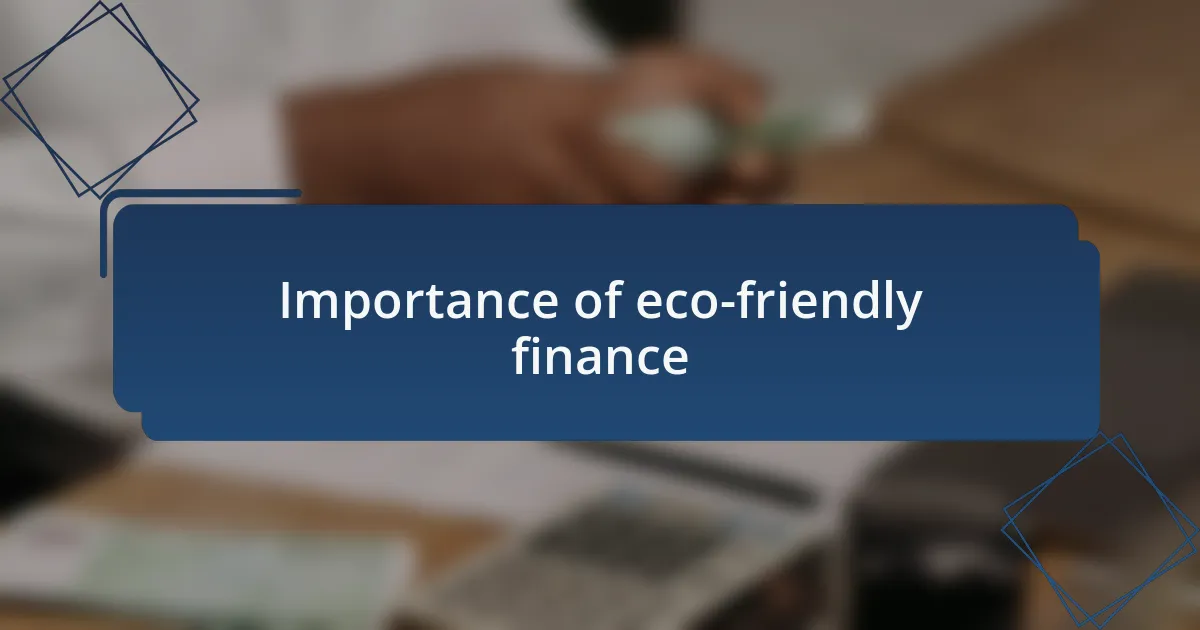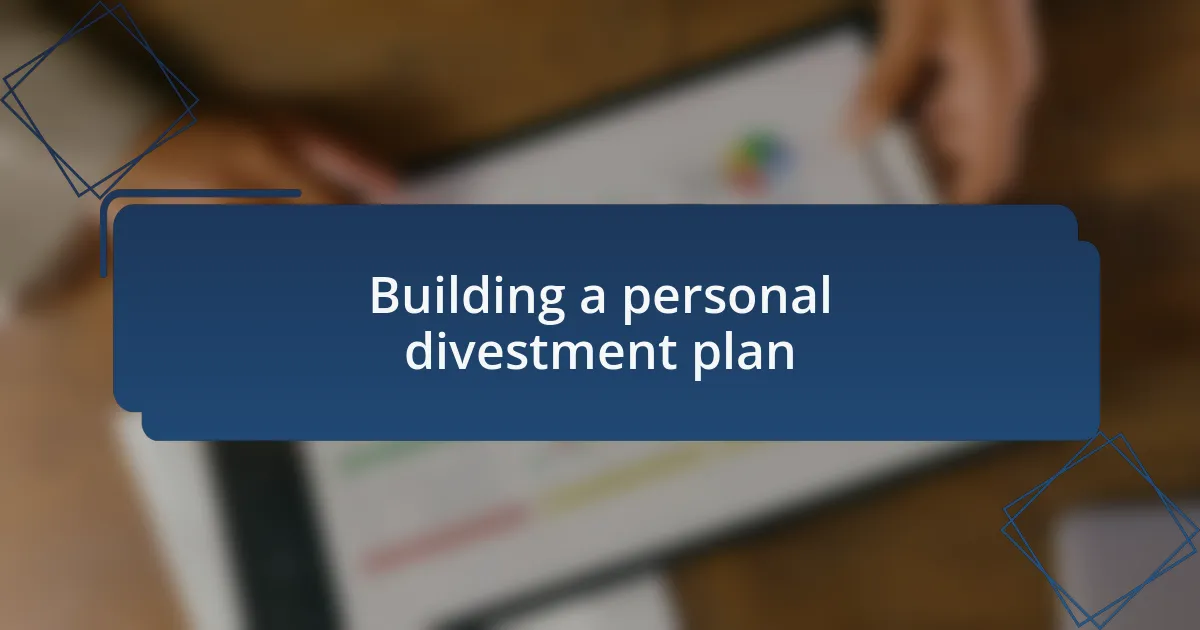Key takeaways:
- Fossil fuel divestment empowers individual investors to align financial choices with values promoting sustainability and addressing climate change.
- Eco-friendly finance not only benefits the planet but often leads to strong financial returns, encouraging businesses to adopt sustainable practices.
- Building a personal divestment plan involves identifying values, assessing current investments, and gradually shifting towards sustainable alternatives.
- Measuring the impact of divestment includes evaluating environmental outcomes and inspiring broader community discussions about sustainability.

Understanding fossil fuel divestment
Fossil fuel divestment is the strategic withdrawal of investments from companies that extract and produce fossil fuels. I remember when I first learned about this movement; it was a pivotal moment for me. It made me realize just how much power individual investors can wield when they collectively choose to align their investments with their values. Why not use our financial choices as a tool for change?
At its core, divestment isn’t just about cutting financial ties; it’s about sending a strong message. It reflects a commitment to sustainability and a recognition of the urgent need to address climate change. When I chose to divest from fossil fuels, it felt empowering. I was no longer indirectly supporting industries that contribute to environmental degradation. Could your investment decisions also reflect your stance on climate issues?
Understanding fossil fuel divestment goes beyond financial implications; it taps into a broader social responsibility. It challenges the status quo and encourages others to reconsider their own investment practices. I often wonder, how many people are unaware of where their money goes? By engaging in discussions about divestment, we can help raise awareness and inspire meaningful change in our communities.

Importance of eco-friendly finance
Eco-friendly finance plays a pivotal role in shaping a sustainable future. When I first embraced this concept, it shifted my perspective on money management entirely. I began to see my financial decisions as not merely personal choices, but as powerful statements about the future I want to support. How can we ignore the impact of our investments on the world around us?
Investing in eco-friendly finance has tangible benefits for both the planet and our portfolios. By directing funds towards renewable energy and sustainable companies, we not only contribute to reducing carbon footprints but also often find ourselves in sectors poised for growth. I recall attending a seminar where an expert shared how green businesses are increasingly outperforming traditional fossil fuel investments. That insight sparked a realization—aligning my finances with my values can also lead to strong financial returns.
Moreover, eco-friendly finance extends beyond individual action; it fosters a movement toward corporate responsibility. I remember discussing with friends how our collective choices could influence companies to adopt more sustainable practices. It’s incredible how our commitment to eco-friendly finance can encourage businesses to innovate and evolve. As investors, can we not drive the change we wish to see? The answer is a resounding yes.

Identifying investment alternatives
Identifying investment alternatives in the realm of eco-friendly finance can feel overwhelming at first, but it opens up a world of possibilities. When I was in the process of divesting from fossil fuels, I took a close look at emerging technologies, like solar and wind energy. Investing in these sectors not only aligns with my values but also signals a readiness for a sustainable future, which excites me.
Another avenue I explored was socially responsible investment (SRI) funds. These funds focus on companies that prioritize environmental, social, and governance (ESG) criteria. I remember when I first realized that my investment choices could reflect my ethical beliefs. It felt empowering to know that every dollar I invested in these funds was also supporting businesses committed to making a positive impact.
I also found great potential in green bonds, which finance projects with environmental benefits. Investing in green infrastructure projects gave me a sense of contributing to something larger than myself. Have you ever considered how your money could help build a cleaner city or a more sustainable community? For me, investing in these alternatives became a personal mission, turning financial decisions into acts of hope for the future.

Building a personal divestment plan
Building a personal divestment plan requires careful consideration of your values and financial goals. I remember sitting down with a notebook, writing down what mattered most to me—climate action, community welfare, and ethical business practices. This exercise helped me clarify my priorities and served as a guiding light as I crafted my divestment strategy.
Next, I created a roadmap of my investments, marking which assets were contributing to fossil fuel industries. I recall the moment I realized how many of my retirement funds were tied up in companies that didn’t align with my values. It felt like a wake-up call. By listing those investments, I was able to visualize the path to divesting, which made the process feel less daunting.
Finally, assessing the timeline for my divestment was crucial. I decided to phase out my fossil fuel investments gradually, allowing me to stay informed about market trends and alternatives over time. Have you ever felt overwhelmed by the idea of change? I found that this gradual approach not only made the transition smoother but also allowed me to learn and adapt along the way. Each step taken became a personal victory, reinforcing my commitment to sustainable investing.

Measuring the impact of divestment
Measuring the impact of divestment extends beyond financial returns; it often includes evaluating environmental and social outcomes as well. One of the most enlightening moments in my journey was witnessing how my choices influenced conversations within my community. It sparked dialogues about sustainability, prompting friends to rethink their own investment strategies. Have you ever felt your decision could ripple outwards in unexpected ways? I certainly did, as my divestment not only reshaped my portfolio but also inspired others to consider their environmental footprint.
To truly gauge the impact, tracking changes in carbon emissions linked to divested companies provides valuable insights. During my research, I discovered that many institutions engaging in divestment reported decreased investment in fossil fuel projects, leading to marked reductions in greenhouse gas emissions. This quantitative shift really struck a chord with me. It emphasized that my decision was not just a personal financial move, but part of a larger collective effort towards a sustainable future.
I also found it crucial to reflect on the moral implications of my divestment. By following ethical guidance from organizations dedicated to sustainable finance, I measured how well my investments aligned with my values over time. At times, I questioned whether I was doing enough, yet each positive change reinforced my resolve. Those small victories taught me that measuring divestment’s impact is as much about personal accountability as it is about tangible results. How do you measure your values amid financial decisions? For me, it became a rewarding journey of alignment and purpose.